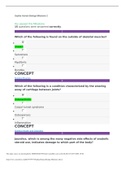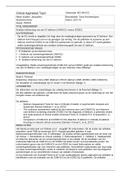Valuations summary of the textbook
written by:
Jacqueline
The study-notes marketplace
Buy and sell all your summaries, notes, theses, essays, papers, cases, manuals, researches, and
many more...
www.stuvia.com
, Stuvia.com - The study-notes marketplace
Chapter 6
Valuations
The valuation of ordinary equity
Valuation of ordinary shares is more difficult than valuing bonds or preference shares for the
following reasons:
o Future cash flows are uncertain- since earnings are dependent on factors such as:
State of the economy
Currency rates
Operating costs
Interest rates
Product acceptance and
The level of competition in the sector
o Ordinary shares have NO maturity-
AND companies are assumed to have an indefinite life
o The cost of capital and cost of equity are subject to greater uncertainty than and more
difficult to observe than bond yields
However the principles still remain the same:
o Valuation of companies remains… PV of future cash flows
o The future cash flows that will accrue to ordinary shareholders- dividends
There are various methods available to determine the value of ordinary equity:
o Dividend growth model:
The value of ordinary equity is determined by PV of future DIVIDENDS
o Price multiples- relative valuation (P/E ratio):
Value of ordinary equity is determined by using price multiples such as
Price earnings ratio &
Market to book ratio
o Free cash flow method:
Determine free cash flows to the firm and discount this at the firm’s cost of
capital
The result is the value of the firm
Deduct the value of debt from the value of the firm to arrive at the value of
ordinary equity
We could ALSO discount the equity cash flows at the cost of equity
o EVA discount model:
Requires that we discount a firm’s future EVA’s at the firm’s cost of capital (refer
to chapters 1 and 5 for additional information if needed)
1
, Stuvia.com - The study-notes marketplace
Dividend growth model:
This model requires that we project the future dividends of the firm and discount the dividends
at the firm’s cost of EQUITY
As the firm has an indefinite life and we can expect the earnings and dividends to grow overtime
o The computation of value is facilitated if we assume a constant growth rate in dividends
Companies will normally only pay out a percentage of earnings and
o The balance is reinvested to generate increased earnings and dividends in future years
Constant growth in dividends:
The assumption of constant growth rate means
o We can use the formula of a growing perpetuity to determine the value of equity
Formula:
Po =value of ordinary share
D1 = NEXT period’s dividend →D1=D0 *(1+g)
k= cost of EQUITY
g= growth rate in future dividends
How do we value share is future periods
If we apply the constant growth dividend model, we need to determine the following 3 variables:
o The next year’s dividend (current dividend* (1+growth rate))
o The discount rate (cost of equity); and
o The growth rate in future dividends
Dividends are a function of
o policy and
o prevailing economic environment
The growth rate in dividends is often difficult to determine and the assumption of a constant
growth rate may NOT be realistic
The dividend growth model may be more realistic when valuing a firm with a
o steady earnings growth
o operating in a mature industry sector
The assumption of a real growth rate similar to
o the expected real GDP growth rate + expected inflation rate
o may be relevant for many companies operating in certain sectors
We can also make further adjustments for productivity improvements
2
written by:
Jacqueline
The study-notes marketplace
Buy and sell all your summaries, notes, theses, essays, papers, cases, manuals, researches, and
many more...
www.stuvia.com
, Stuvia.com - The study-notes marketplace
Chapter 6
Valuations
The valuation of ordinary equity
Valuation of ordinary shares is more difficult than valuing bonds or preference shares for the
following reasons:
o Future cash flows are uncertain- since earnings are dependent on factors such as:
State of the economy
Currency rates
Operating costs
Interest rates
Product acceptance and
The level of competition in the sector
o Ordinary shares have NO maturity-
AND companies are assumed to have an indefinite life
o The cost of capital and cost of equity are subject to greater uncertainty than and more
difficult to observe than bond yields
However the principles still remain the same:
o Valuation of companies remains… PV of future cash flows
o The future cash flows that will accrue to ordinary shareholders- dividends
There are various methods available to determine the value of ordinary equity:
o Dividend growth model:
The value of ordinary equity is determined by PV of future DIVIDENDS
o Price multiples- relative valuation (P/E ratio):
Value of ordinary equity is determined by using price multiples such as
Price earnings ratio &
Market to book ratio
o Free cash flow method:
Determine free cash flows to the firm and discount this at the firm’s cost of
capital
The result is the value of the firm
Deduct the value of debt from the value of the firm to arrive at the value of
ordinary equity
We could ALSO discount the equity cash flows at the cost of equity
o EVA discount model:
Requires that we discount a firm’s future EVA’s at the firm’s cost of capital (refer
to chapters 1 and 5 for additional information if needed)
1
, Stuvia.com - The study-notes marketplace
Dividend growth model:
This model requires that we project the future dividends of the firm and discount the dividends
at the firm’s cost of EQUITY
As the firm has an indefinite life and we can expect the earnings and dividends to grow overtime
o The computation of value is facilitated if we assume a constant growth rate in dividends
Companies will normally only pay out a percentage of earnings and
o The balance is reinvested to generate increased earnings and dividends in future years
Constant growth in dividends:
The assumption of constant growth rate means
o We can use the formula of a growing perpetuity to determine the value of equity
Formula:
Po =value of ordinary share
D1 = NEXT period’s dividend →D1=D0 *(1+g)
k= cost of EQUITY
g= growth rate in future dividends
How do we value share is future periods
If we apply the constant growth dividend model, we need to determine the following 3 variables:
o The next year’s dividend (current dividend* (1+growth rate))
o The discount rate (cost of equity); and
o The growth rate in future dividends
Dividends are a function of
o policy and
o prevailing economic environment
The growth rate in dividends is often difficult to determine and the assumption of a constant
growth rate may NOT be realistic
The dividend growth model may be more realistic when valuing a firm with a
o steady earnings growth
o operating in a mature industry sector
The assumption of a real growth rate similar to
o the expected real GDP growth rate + expected inflation rate
o may be relevant for many companies operating in certain sectors
We can also make further adjustments for productivity improvements
2





